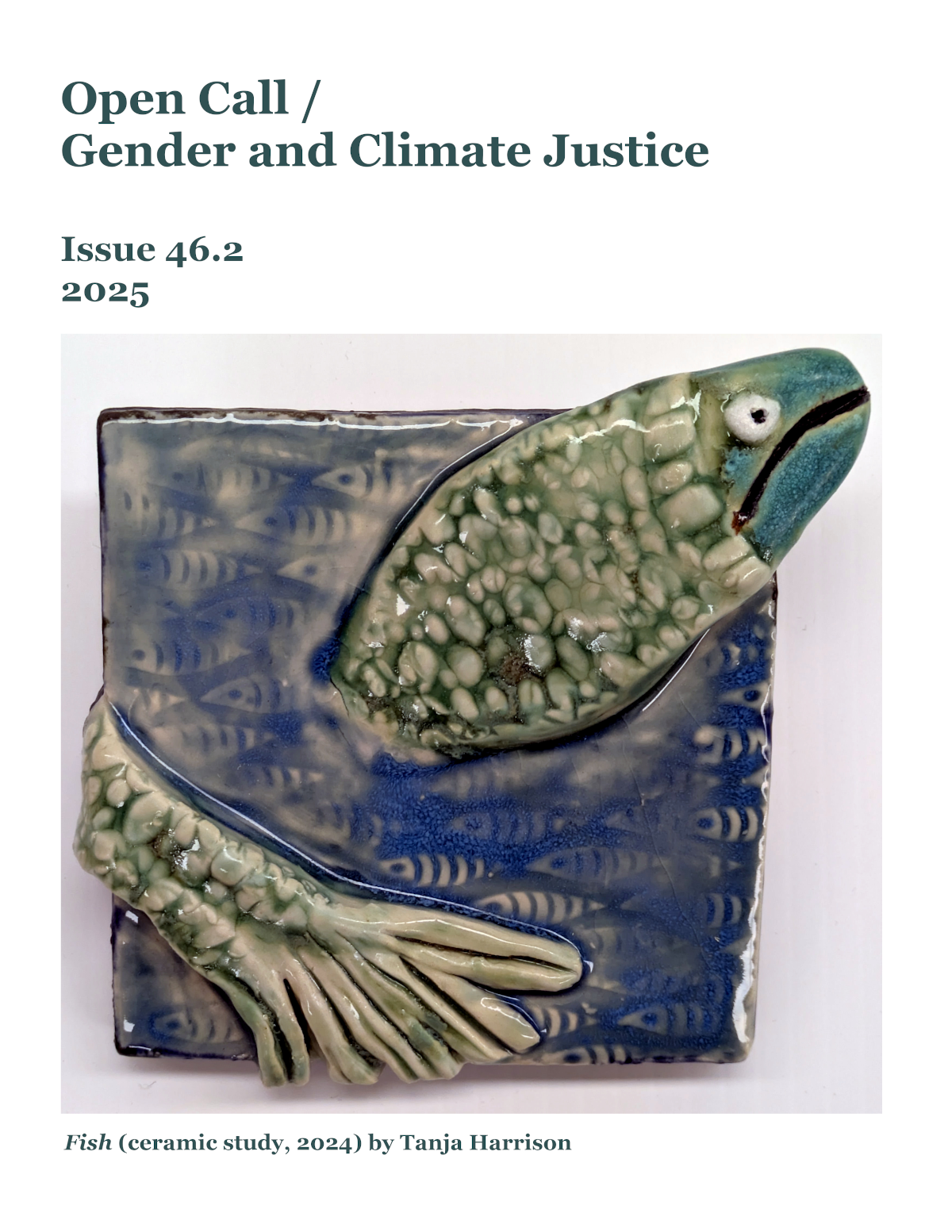Les masculinités à la croisée des chemins
Perspectives théoriques sur la violence fondée sur le genre et la classe sociale dans Lajja de Taslima Nasrin
Mots-clés :
violence fondée sur le genre, identité, intersectionnalité, masculinités, altérité, classe socialeRésumé
Le présent article offre une analyse critique de la complexité des espaces réservés aux hommes ou aux femmes dans Lajja (2014) de Taslima Nasrin. Il vise à éclaircir la position sociale des hommes au sein des communautés minoritaires dans les scénarios de conflit. S’appuyant principalement sur les théories de Susan Bordo, Michael Kimmel et Raewyn Connell, entre autres, l’article souligne les complexités entourant la violence fondée sur le genre et la formation de l’identité masculine. Il met en lumière l’émergence d’une masculinité subalterne, à laquelle s’ajoutent les réalités incarnées de la masculinité. Cela favorise un sentiment d’« altérité » chez les hommes appartenant à des groupes minoritaires, qui renforce le traumatisme psychologique et physique que subissent les corps masculins dans le discours sur la violence fondée sur le genre. Cet article se penche sur les intersections complexes des identités raciales et ethniques au sein de la dynamique des classes sociales, révélant les multiples facettes de l’expression de la masculinité au sein de diverses communautés. En adoptant un point de vue axé sur la violence fondée sur le genre, j’explore les défis particuliers et les expériences vécues par les hommes confrontés à l’entrecroisement complexe de plusieurs facteurs identitaires. La recherche examine l’invisibilité systématique des victimes qui s’identifient comme des hommes sur le continuum des genres, juxtaposée à leur association injuste avec l’image de l’agresseur. Essentiellement, cette étude enrichit le discours théorique sur les liens entre masculinité et classe sociale, en révélant les multiples facettes de la violence fondée sur le genre à l’encontre des hommes dans le contexte socioculturel unique dépeint dans Lajja.
Références
Bordo, Susan. 1999. The Male Body: A New Look at Men in Public and in Private. The University of California Press.
Brod, Harry. 2018. The Making of Masculinities (Routledge Revivals): The New Men's Studies. Routledge.
Carpenter, R. Charli. 2006. “Recognizing Gender-based Violence Against Civilian Men and Boys in Conflict Situations.” Security Dialogue 37 (1): 83-101.
Connell, Raewyn. 2005 (1995). Masculinities. University of California Press.
De Kock, Leon. 1992. “An Interview with Gayatri Chakravorty Spivak.” Ariel: A Review of International English Literature 23(3): 29-47.
Dolan, Chris. 2014. Into the Mainstream: Addressing Sexual Violence Against Men and Boys in Conflict. Vol. 14. Briefing paper prepared for a workshop held at the Overseas Development Institute, London.
Geertz, Clifford. 1973 (2017). The Interpretation of Cultures. Basic Books.
Gottschall, Jonathan. 2004. “Explaining Wartime Rape.” The Journal of Sex Research 41(2): 129–136.
Gramsci, Antonio. 1971. Prison Notebooks. Translated by Quentin Hoare and Geoffrey Nowell Smith. Lawrence and Wishart.
Hage, Ghassan. 2009. “Waiting Out the Crisis: On Stuckedness and Governmentality.” Anthropological Theory 5(1): 463–475.
Halder, Deep. 2024. “Taslima Nasrin’s Lajja has a ‘Go to India’ Message. As a Play Now, It’s a Bold Nod to CAA.” The Print. 19 November. https://theprint.in/feature/taslima-nasrins-lajja-has-a-go-to-india-message-as-a-play-now-its-a-bold-nod-to-caa/2362511/
Haywood, Chris, Thomas Johansson, Nils Hammarén, Marcus Herz, and Andreas Ottemo. 2018. “Approaching Men and Masculinities.” In The Conundrum of Masculinity: Hegemony, Homosociality, Homophobia and Heteronormativity edited by Chris Haywood et al. Routledge.
hooks, bell. 2004. The Will to Change: Men, Masculinity, and Love. Washington Square Press.
Karmakar, Goutam. 2020. “The Body and Sexuality in Cultural Representation: An Interview with Susan Bordo.” Journal of Gender Studies 30(7): 855-863.
Kimmel, Michael. 2010. Misframing Men: The Politics of Contemporary Masculinities. Rutgers University Press.
_____. 2011. “The Social Construction of Gender Relations.” In The Gendered Society, edited by Michael Kimmel. Oxford University Press.
Minorities Rights Group. 2019. Communities (sub-section). Bangladesh. Available at: https://minorityrights.org/country/bangladesh/
Nasrin, Taslima. 2014 (1993). Lajja. Penguin Random House.
Ropar, Michael., & John Tosh. 2021 (1991). Manful Assertions: Masculinities in Britain Since 1800. Routledge.
Shahisullah, Mohammad. 2016. “Under Threat: The Challenges Facing Religious Minorities in Bangladesh.” Minority at Risk International Report. Produced with the Swedish International Development Cooperation Agency. REUTERS.
Sinha, Mrinalini. 1995 (2017). Colonial Masculinity: The ‘Manly Englishman’ and the ‘Effeminate Bengali’ in the Late Nineteenth Century. Manchester University Press.
Sivakumaran, Sandesh. 2007. “Sexual Violence Against Men in Armed Conflict.” European Journal of International Law 18(2): 253-276.
Solangon, Sarah & Preeti Patel. 2012. “Sexual Violence Against Men in Countries Affected by Armed Conflict.” Conflict, Security & Development 12(4):17–442
Strachey, J. (1888) 1911). India, Its Administration and Progress. London: Macmillan &. Co., pp. 449-50.
UN Office for the Coordination of Humanitarian Affairs (UN OCHA). 2008. “The Nature, Scope, and Motivation for Sexual Violence Against Men and Boys in Armed Conflict.” Paper presented at UN OCHA Research Meeting, New York, June.
UNHRC. 2004. Minorities at Risk Project, Chronology for Hindus in Bangladesh. available at: https://www.refworld.org/docid/469f3869c.html [accessed 20 November 2024]
Wong, Y. Joel, and Wang, Shu-Yi. 2022. Toward an Integrative Psychology of Masculinities. Psychology of Men & Masculinities 23(3): 285–298.
Téléchargements
Publié
Numéro
Rubrique
Licence
© Sanjana Chakraborty, Dhananjay Tripathi 2025

Cette œuvre est sous licence Creative Commons Attribution 4.0 International.
Les auteurs qui publient dans cette revue acceptent les conditions suivantes:
1. Les auteurs conservent les droits d’auteur et accordent le droit de première publication à la revue. L’œuvre est simultanément sous licence internationale Creative Commons Attribution 4.0 qui permet à d’autres personnes de la partager en citant dans les remerciements l’auteur de l’œuvre et sa publication initiale dans cette revue.
2. Les auteurs savent que les articles publiés dans Atlantis sont indexés et disponibles par le biais de divers outils de recherche universitaires et professionnels, y compris, entre autres, Erudit.
3. Les auteurs peuvent conclure des ententes contractuelles supplémentaires et distinctes pour la distribution non exclusive de la version de l’article publiée par la revue (c’est-à-dire, l’afficher dans un dépôt institutionnel ou la publier dans un livre), en signalant qu’elle a été initialement publiée dans cette revue.
4. Les auteurs sont autorisés et encouragés à prépublier leur œuvre, c’est-à-dire à la publier en ligne (dans un dépôt institutionnel ou sur leur site Web, par exemple) avant et pendant le processus de soumission. Cela peut conduire à des échanges productifs, ainsi qu’à ce que le travail publié soit cité plus tôt et plus souvent. Renseignez-vous davantage ici sur la prépublication.







